Masks and Faces: Marino Marini’s Dialogue with Antiquity in Female Nudes and Portraits
Giorgio Motisi Giorgio Motisi Marino Marini, Issue 5, May 2021https://italianmodernart-new.kudos.nyc/journal/issues/marino-marini/
In a long-ignored text, the painter Gabriele Mucchi recalls Marino’s relationship with a fine arts student named Sistina. According to Mucchi, this girl “posed for some versions of the Pomona” and “stayed with Marino until he abandoned her for a girl who oddly resembled her: Mercedes.” This sentence helps to better understand the so-called “portrait” Sistina (c. 1938). This terracotta head, though, seems to have nothing to do with Marini’s several portraits of Mercedes. Instead, it is similar to the faces of some of his female nudes of the late 1930s. Considering both these observations and Mucchi’s testimony, the work cannot be defined as a “portrait” in the strict sense of the word. It is, more likely, a part of a full-length figure, from which it was detached at an unknown date. In other words, Sistina is the model, but she is not portrayed. The Sistina episode leads us to reconsider some differences in the artist’s work on female nudes, on the one hand, and portraits, on the other. Starting from this reflection, the second part of the paper is devoted to Marini’s dialogue with antiquity in the two genres taken into account. Firstly, the text focuses on the sculptor’s attention to some ancient models. In his full-length figures, for example, Marini mainly refers to the seductive bodies and the static faces of Greek art. In particular, the latter seem to be employed as inexpressive “masks” useful for bringing out, by contrast, the vital sensuality of the female nudes. Contrariwise, his portraits seem rather linked to Etruscan, Roman, Egyptian, and Renaissance models, conceived as examples of strong individual characterization. Secondly, the article aims to analyze the surface treatment in the two distinct genres. On the one hand, the scratches on the female nudes provide a new intense humanity and pictorial allure to the plastic construction of volumes. On the other, scraping interventions on the portraits were employed especially to avoid excessive realism and to accomplish an elegant archaeological effect. In both cases, Marino was like an imaginative archaeologist. Through opposite ways, he created his fascinating characters, ancient yet modern.
Sistina, a model
In a text so far ignored by studies on Marino Marini, the painter Gabriele Mucchi recalls the sculptor’s relationship with a fine arts student named Sistina. Mucchi was Marini’s neighbor in Milan in the 1930s and seems to have been well-informed about his personal life. According to Mucchi, this girl “posed for some versions of the Pomona” and “stayed with Marino until he abandoned her for a richer girl named Mercedes, who oddly resembled her and who would later become his wife.”1 The memory is dated to many years later (around 1980), and at first glance it might not seem entirely accurate. In fact, more than to the Pomone, the painter was probably referring to the Giovinette, or “young ladies.” The latter title, indeed, was used for most of Marini’s female nudes of the 1930s when they were initially exhibited, and it is still applied today.
Despite this small inaccuracy, the story rings true. Moreover, it seems to be confirmed by a drawing made by Mucchi in 1940 for Il Tesoretto, a sort of artistic-literary almanac published annually by Mondadori.2 The sketch, Via Rugabella, depicts a small street in Milan where many artists and writers lived (figure 1). At number 9, a large building is portrayed. The names of the respective tenants are indicated in correspondence with the windows. These include the artists Pompeo Borra, Aldo Salvadori, and Domenico Cantatore, among many others. The most interesting detail, however, concerns Marini: although in different apartments, the names “Marini” and “Sistina” can clearly be read in the same building.
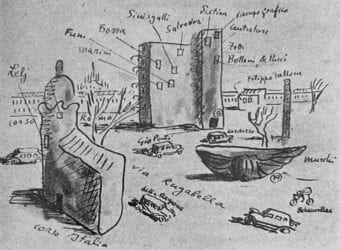
It should come as no surprise that a fine arts student was living on via Rugabella at the time. The street was truly a hub for the younger generation of artists in Milan.3 Similarly, it is quite understandable that a young girl interested in the art world also worked as a model to earn some extra money. During those years, relationships between artists and their models were still a widespread phenomenon. It is therefore easy to imagine a special intimacy between Marini and his neighbor Sistina. It is also true, however, that the sculptor married Mercedes Pedrazzini on December 14, 1938.4 One can imagine that the artist’s affair with Sistina occurred in the mid-1930s and ended around 1938.
Mucchi’s memory offers much more than a simple curiosity about the sculptor’s sentimental life. First of all, it allows for a better understanding of a relatively unknown work by Marini: Sistina (c. 1938; figure 2). Sistina is a terracotta head, once owned by Raffaele Carrieri and now in a private collection.5 In the Marini catalogue raisonné, it is generically dated to 1935–36.6 Nevertheless, a stylistic analysis points to a slightly later date. Despite the lack of information about this supposed portrait, it is worth the attempt to examine it more accurately.
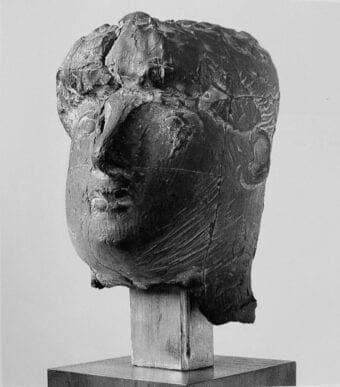
Firstly, the size of the head (8 5/8 x 6 11/16 x 5 7/8 in.; 22 x 17 x 15 cm) is quite a bit smaller than many other portraits by Marini. Secondly, even if the title suggests a portrait, Sistina seems to lack a real personal characterization. It is true that the features of the face are generally referenceable, they nevertheless tend towards overall simplification. Lastly, there is a clear resemblance to the faces of some of the artist’s female nudes of the late 1930s. This is the case, for example, with the Giovinetta of 19387 whose plaster version was exhibited at the Quadriennale in Rome in 1939 (figure 3).8 Just like Sistina, this Giovinetta features short hair gathered up into a bob, ears flattened against the head, a rounded facial appearance, small but fleshy lips, and a straight nose directly connected to the forehead. Furthermore, we can see in both works an intentional superficial imperfection under the left eye, and similar structural lines connecting the various parts of the head. If we take into account these observations and Mucchi’s memory, there can only be one conclusion about Sistina: the work cannot be considered a real portrait, but rather a part of a full-length figure, made around 1938. In other words, Sistina is the model, but she is not portrayed. Summing up, we can imagine that the head was detached only at a later time.
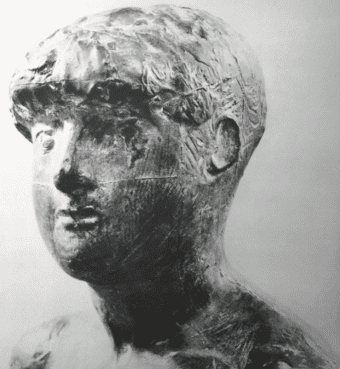
After all, this is not an isolated episode in Marini’s production. A similar case also occurs with a Female Portrait (1942, this is the title in the artist’s catalogue raisonné).9 Indeed, the head in question is nothing more than a bronze cast taken from the head of a plaster Pomona decapitated by the sculptor around 1941.10 Likewise, Sistina must come from a specific female nude. For example, it could be related to a certain Giovinetta currently in a private collection (no. 149 in the artist’s catalogue raisonné; figure 4).11 Alternatively, Sistina could have belonged to a very similar work, either destroyed or not included in the artist’s catalogue raisonné. For the time being, it is worth focusing on the Giovinetta, as among the works made by Marini in those years it is the only headless female nude in terracotta still known today.
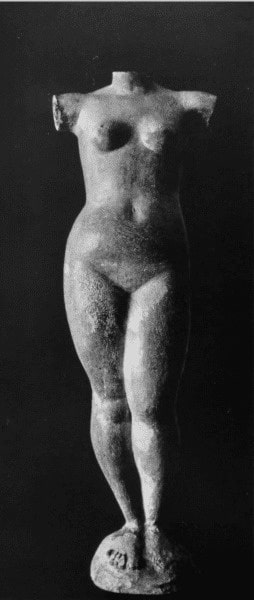
The headless Giovinetta (in some cases titled Venere, or Venus) has been erroneously dated to 1945 for decades.12 ‘As a matter of fact, there are many elements that suggest an earlier date. Firstly, a headless terracotta female nude is mentioned in the catalogue of Marini’s exhibition held in Genoa in March 1941.13 Moreover, in the same catalogue we can find the photograph of a very similar headless sculpture labeled “Nude, terracotta” (figure 5).14
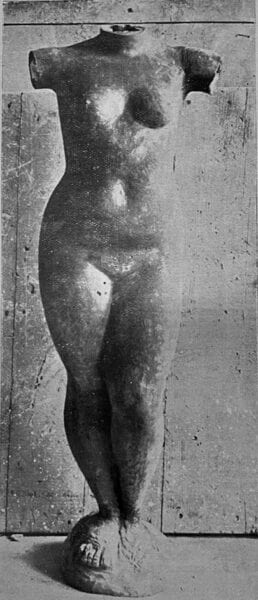
In any case, the most useful information about the sculpture comes from its stylistic examination. The distance between this piece and the overweight and harshly realistic nudes of the early 1940s leads us to consider it an earlier work. In addition, a strong resemblance can be noted with other Giovinette of the late 1930s, such as the one in the 1939 Quadriennale, which is also known in a terracotta version (figure 6). This similarity confirms that the sculpture may have been made in the same period, that is, around 1938, a date which could bring it closer also to Sistina.
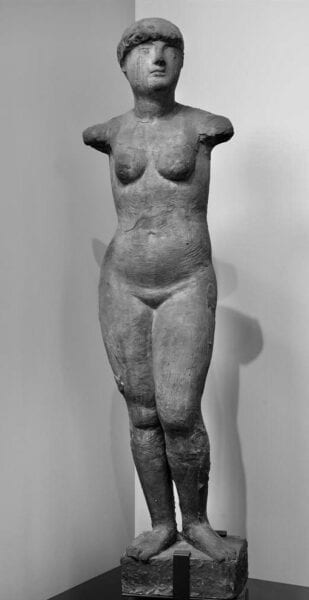
A more accurate inspection reveals that the two Giovinette, the headless one and the one exhibited at the Quadriennale, have many things in common. Not only do they share the amputated arms and the scratched surfaces, but the two nudes also feature a similar pose, with the same small breasts on an extremely similar shape in the buttocks and legs, plump and yet compact. Moreover, we must not overlook another crucial point: the striking resemblance already highlighted between Sistina and the face of the Giovinetta shown at the Quadriennale. Ultimately, regardless of the possibility of conclusively reconnecting the head of Sistina with the headless Giovinetta in terracotta, it is clear that all three works are closely linked. Sistina and the two Giovinette can be considered part of a single moment of Marini’s reflection on the female nude and its expressive possibilities; they belong to a phase that took place around the late 1930s and was likely related to a specific model, Sistina.
The Sistina episode leads us to reflect both on Marini’s way of conceiving the female nude and on his approach to rendering facial features. The bodies of the two Giovinette could be said to resemble each other because the model is the same; but the resemblance could also depend on a similar plastic effect sought with a substantially abstract approach. In 1939, in the magazine Tempo, Marini spoke of his nudes as a “search for forms, lines, masses.”15 But can the model’s tangible body really lose all its relevance as a starting point? Besides, do the sculptures’ faces maintain a link with reality, or are they purely conventional? As already pointed out, Mucchi recalled a striking resemblance between Sistina and Mercedes. And yet, except for the big nose, the works considered so far seem to have nothing to do with the appearance of the sculptor’s wife; rather, both the photographs and the portraits of Mercedes (or rather, Marina, as Marini affectionately nicknamed her) clearly show an angular, elongated, and very different face.
Such incongruity obviously responds to a different conception of personal identity – in the faces of female nudes, on the one hand, and in the portraits, on the other. This highly complex issue cannot certainly be analyzed exhaustively here. However, from this perspective, a first, useful step can be taken towards understanding how this double approach affected the artist’s dialogue with ancient sculpture. Marini’s attention to ancient sources has been frequently discussed in rather generic terms. By contrast, hardly ever has an attempt been made to point out how different archaeological models were chosen by the sculptor in order to solve different expressive challenges.
In 1942, Giulio Carlo Argan ironically defined Marini as a “terrible philologist.” According to him, the sculptor was like a researcher of archaeological antiquities who “accepts historical data as he finds them, confused, worn-out, scalped, encrusted.”16 Actually, though, Marini merely pretended to be inattentive in his retrieval of antique works. His decision to borrow the eroded appearance of some ancient artifacts was mainly aimed at satisfying an archaeological taste for fragments, which was extremely widespread in Italy at the time.17 In truth, on several occasions the sculptor proved to be a very precise and attentive “archaeologist,” keeping abreast of the scholarly work carried out by specialists. From this perspective, the difference between his female nudes and portraits is a case in point.
Female Nudes as Modern Aphrodites
Let us consider the ancient nudes first. To understand the common conception of these works in Italy during the 1930s, the chief reference text is Il nudo nell’arte (The nude in art, 1930), by Alessandro Della Seta, a professor of archaeology in Rome and a member of the Accademia dei Lincei, one of the most prestigious Italian cultural institutions.18 Therefore, it is no surprise that for several years his richly illustrated volume was a reference point, not only for scholars, but also for many Italian artists. Della Seta based his book on a very specific thesis, that the only ancient art that truly dealt with the representation of the nude was the Greek one. Greek culture was, in Della Seta’s time, considered the most closely related to the notion of man as measure of the world. Conversely, the Egyptian, Etruscan, and Roman arts were regarded as too linked to individual, political, or funerary purposes. For this reason, they would not have been called upon in the same way to study the pure forms of the human body.19
More specifically, the female nude and its values of plastic delicacy were conceived as peculiar to the Hellenistic age (323–31 BCE).20 Like all Italian archaeologists, Della Seta had no doubts about the two most valuable examples of this genre: the Esquiline Aphrodite and the Aphrodite of Cyrene (figures 7 and 8).21 The two works’ primacy also depended on issues of national pride. The Esquiline Aphrodite, now in the Capitoline Museums, had been unearthed in Rome in 1874; from that moment it came to represent a true icon of the city’s archaeological heritage.22 The Aphrodite of Cyrene had been found in Libya in 1913, during the Italo-Turkish War. It was immediately brought to Rome and soon became a symbol of Italian colonialist politics.23 In this respect, the fact that in the 1930s the work was printed on stamps of the Poste Coloniali (the colonial postal service) is highly significant (figure 9). However, the quality of the two works was substantially assessed on the basis of three stylistic criteria, regarded at the time as essential to judging the female nude.
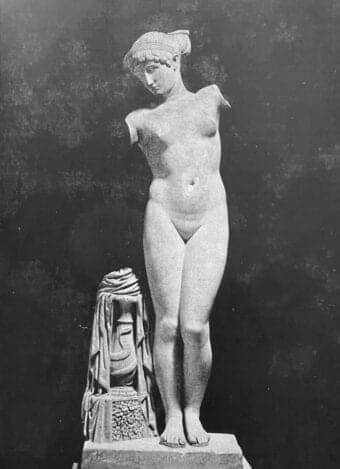
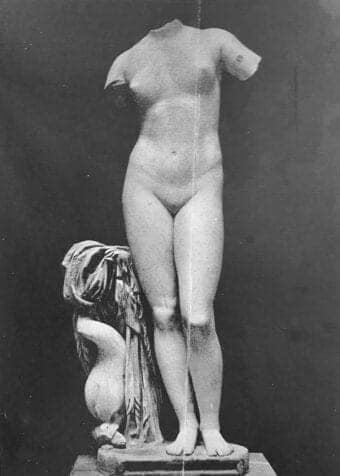
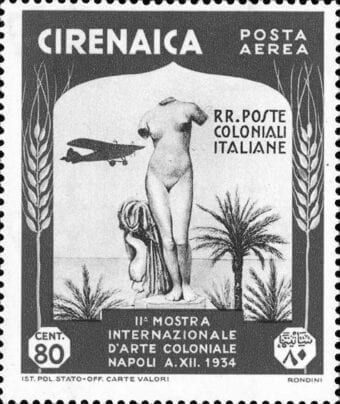
The first, perhaps unexpectedly, involves the need to keep a distance from an overly idealized physique. For both the Aphrodite of Cyrene and the Esquiline Aphrodite, it was pointed out that “behind the form there is a real woman with her qualities and her flaws.” In both cases, the subject was defined as “a woman of medium stature” with “a typical disproportion, the robust development of the lower body.” Even the pose of the legs, one slightly crossed over the other, highlighted the stocky appearance of buttocks and thighs. In this way, while maintaining a compact compositional balance, the works gained a more intense liveliness and expressive vibrancy.24
The second aspect concerns the face. In this case, the view expressed about the body was completely overturned. Indeed, it was widely held that a too realistic face could weaken the beauty of the nude. The Capitoline Aphrodite, another of the most famous sculptures at the time, was taken as such a negative example. Despite the recognized high quality of the work, the sculpture’s face was considered too close to that of the model in the flesh. So, Della Seta had no doubts: “If the sculpture had the misfortune to come to us headless, it would have had the fortune to do more justice to its art.”25 By contrast, the problem arose neither for the Aphrodite of Cyrene nor for the Esquiline Aphrodite. The first had been found already headless; the second, with the neo-archaist expressiveness of its face, did not risk of distracting attention from the body.
The third aspect is probably the most interesting. It concerned the innate “chromatic” richness of the female nude’s surface. According to Italian archaeologists, the male body was the one that lent itself best to the plastic analysis of a well-defined muscular structure. Conversely, the female nude was regarded as an opportunity to reflect on more sensual and delicate chiaroscuro effects. Della Seta wrote: “At all times the female body, for the delicacy of its surfaces, besides being plastic, has been color.”26 For this reason, according to common opinion at the time, the best female nudes never featured smooth or too polished surfaces, and thus didn’t risk a cold or inert aspect. On the contrary, it was better to leave some irregularities and imperfections. This way, “the movement of the planes preserved the softness of the living flesh.”27 Unsurprisingly, even the photographs published in the Della Seta volume emphasize the pictorial effects and the rich superficial texture of these sculptures through meticulous lighting.28
It goes without saying that Marini did not aim to conform trivially to the critical judgement of ancient works. Nevertheless, it is important to take into account the centrality of the archaeological horizon in Italian culture during his lifetime, even for a modern sculptor.29 From this perspective, it is impressive how closely Marini’s artistic production seem to echo Della Seta’s observations.
Firstly, both of Marini’s aforementioned Giovinette reveal a studied attention to the Aphrodite of Cyrene and to the Esquiline Aphrodite in their general structure and in specific details. Moreover, they are not isolated cases: other female nudes realized in the late 1930s seem to refer to these two statues of Aphrodite that were kept in museums collections in Rome.30 Clearly, they are not the only models Marini looked at. Yet while the connection between the artist’s sculptures and famous works such as Aristide Maillol’s Venus sans bras (Armless Venus, 1922) has been pointed out by other scholars,31 it also seems that Marini was not interested in the excessive coldness and plastic perfection of Maillol’s works. Marini’ s nudes are much shorter, they have a stockier and more irregular appearance, their breasts are smaller and resemble those of a young adolescent, the pubic and gluteal areas are analyzed with a more precise and stinging attention, and even their amputated arms appear very different and more similar to stumps.
All these aspects make Marini’s bodies look much more realistic and pathetic. Moreover, it seems the artist was emphasizing precisely the physical imperfections highlighted by scholars in both the Aphrodite of Cyrene and the Esquiline Aphrodite. Marini’s purpose is clear and the same as that detected in the work of ancient sculptors: to constantly remember the vivid presence of the model in the flesh, in an attempt that can be regarded as the very key point of the work. Maillol modeled his sculptures with purely decorative and abstract shapes in mind. Marini, also on the basis of ancient models, seems to have conceived the study of form as the result of a more direct and necessary dialogue with reality, so that his female nudes always show a new and more complex vitality. In 1947, the gallerist Stefano Cairola noted that Marini’s nudes had “the same plastic absoluteness of Maillol’s ones, but with a breath of life that emphasized the models’ individuality.”32 Bearing Cairola’s statement in mind, we can imagine that in his Giovinette Marini remained particularly close to the real body of Sistina, or of whoever was his model.
Further, Marini turns out to have been concerned also about the risk that too realistic faces could compromise the expressiveness of his nudes. Here as well, the sculptor applied solutions suggested by archaeological models and stressed by scholars. For example, by severing the head of both Sistina and the Giovinetta in terracotta – a solution that, at the time, unequivocally referred to the Aphrodite of Cyrene – the sculptor not only made a choice that fulfilled a practical purpose, he also pursued an explicit archaeological fascination.
In many other cases the solutions applied by the artist appear closer to that of the Esquiline Aphrodite and other sculptures of the late Hellenistic age. Indeed, following from sculptors of the first century BCE, Marini pursued certain neo-archaic traits, typical of more ancient works (dating to the early fifth century BCE): the perfectly oval face, the large and almost etched eyes, and the straight nose directly connected to the forehead and brow ridge (figure 10). The effect is that of a complete motionlessness. Preclassical faces were conceived by the artist as inexpressive “masks,” useful to bringing out, by contrast, the vital sensuality of the nude bodies.
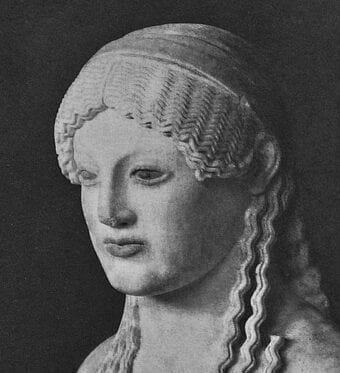
At the same time, Marini seems also to have reflected on a contemporary equivalent of this quiet expressionlessness. From this point of view, he finds a further crucial model in Pablo Picasso’s classicist works of the 1920s (figure 11).33 Art critics immediately noticed this similarity as well. As early as 1939, for example, Eleonora Della Pura highlighted the “round Picasso face” of Marini’s Giovinetta at the Quadriennale.34 Moreover, in the case of Sistina, it is impressive how the scratches engraved on her neck directly refer to some typically Picassian shadings (figure 2). Marini’s attention to Picasso could not be more evident.
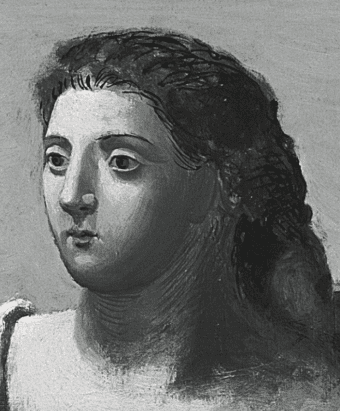
Finally, it is worth considering the echo of archaeological considerations on the “chromatic” richness of the surfaces of ancient Aphrodites. Indeed, Marini was deeply influenced by this as well. Already with his female nudes of the 1930s the sculptor was working on a double track. On the one hand, of course, he was focused on the plastic synthesis of volumes; on the other, though, is the peculiar care he applied to transitions between planes and the graphic enrichment of surfaces. Thus, the skin of the Giovinettes appears always speckled, nicked, and scratched – an effect which suggests a pictorial interpretation of the works and an ambiguity with the real model’s living flesh.
Surface interventions provide a new intense humanity and pictorial allure. They interfere with the plastic construction and complicate the volumes’ system. We have to admit that there is nothing archaeological about this optical disturbance effect. On the contrary, it enriches the forms of a more problematic and modern evidence. Despite this, paradoxically, a basic inspiration seems to have come to Marini precisely from archaeological studies. That is where the principal considerations on the female nude and its pictorial value came from in these years. From this perspective, some photographs of a Giovinetta published in the magazine Civiltà in 1942 are particularly revealing (figure 12).35 The work is photographed outdoors, as if it were an archaeological find. And yet, its most evident aspect is the provocative sensuality of the surface, which is extremely similar to a model in the flesh.
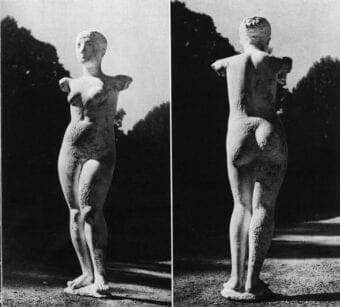
Portraits: Between Realism and Archaeological Abstraction
Like female nudes, ancient portraits enjoyed considerable critical success in the 1930s. Here again, it is possible to identify a useful reference text on the subject: Il ritratto nell’arte antica (The portrait in ancient art, 1934), by Roberto Paribeni, who was then a particularly influential figure on the Italian cultural scene. Paribeni was a professor of archaeology at the “Cattolica” University of Milan and the president of the Italian Royal Institute of Archaeology and History of Art.36 Therefore, it is no surprise that even his book quickly achieved canonical value in Italy.
Paribeni rooted his analysis in the main assumption shared by Italian archaeological studies on the topic: despite the great stylistic quality reached in nude sculpture, Greek art did not excel to the same extent in portraiture, instead remaining too closely linked to purely formal and almost abstract research. For this reason, it had not been able to deal with the notion itself of the single individual. By contrast, portraiture had been the primary focus of two other great ancient artistic traditions: the Egyptian and the Italic (the latter included both Etruscan and Roman art).37
In those years Italian scholars used to interpret the Egyptian portraiture by relating it to the so-called Ka, a typical concept of the ancient pharaohs’ religion. Significantly enough, the clearest explanation of this word can be found not in an archaeological textbook, but in a famous handbook for the young modern artist: Discorsi su la scultura (Lectures on sculpture, 1931), by Michele Guerrisi, a professor at the Accademia Albertina in Turin.38 The Ka, as Guerrisi explained, was a “mediumistic projection” and a “double of the body,” which after death requires a new and tangible shelter.
Therefore, the solid and powerful appearance of Egyptian portraits was commonly reconnected to this need. In these ancient works, based on an ideal of geometric balance and made of durable materials, the Ka could rest for eternity. Such ideas were also the basis for Paribeni’s considerations on the topic. In particular, he gave attention to the portraits of the pharaoh Amenhotep IV (also known as Akhenaten) and his family (fourteenth century BCE). These were recognized as the highest quality and most realistic works in all of Egyptian portraiture. It is not by chance that Paribeni wrote (even with a bit of imagination) that Amenhotep’s battle name meant “he who lives by the truth.”39
In the same years, an even greater interest in portraits of the Italic tradition developed. As a matter of fact, until the beginning of the twentieth century, both Etruscan and Roman art were considered mere epigones of Greek art. The reason was simple: in accordance with an approach still linked to Johann Joachim Winckelmann – and his landmark History of Art in Antiquity, published in 1764 – only ancient Greece was seen as the true embodiment of an ideal (and often idealized) classic.40 By contrast, in the 1920s and 1930s there was a constant attempt by Italian critics to highlight peculiar elements of the ancient Italic arts. A gradual reevaluation of Etruscan art had begun with the discovery of the Apollo of Veii in 1916,41 and, simultaneously, unprecedented attention to the peculiarities of Roman art flourished.42 It was a trend clearly influenced by political and nationalistic ideals.43 Nevertheless, this research brought to light some very interesting themes.
Among the main features, the notion of a typical Italian inclination toward realism emerged. Unsurprisingly, the idea of a realistic art soon led to reflection on the absolute centrality of the portrait genre in the national tradition. It is no coincidence, for example, that Paribeni praised the ancient portraits especially for “expressive, instantaneous, almost fierce virtues, which capture and impress a living reality.”44 More generally, the greatest results of Roman portraiture were commonly recognized by scholars in the works of the republican age and late antiquity. These were the less idealized portraits of tradition, appearing irregular, clumsy, and often on the edge of caricature; and yet, precisely because of this, they were perceived as the most lively, expressive, and fascinating.45
Here again, such archaeological considerations seem to have profoundly influenced Marini’s work. As with the nudes, the sculptor demonstrated a notable ability to interpret different suggestions. The ancient sources are always revived by him with a free and original approach. For this reason, the best way to deal with this heterogeneous theme is to analyze some specific episodes.
Let us consider two portraits from the mid-1930s: Lucosius (1935; figure 13)46 and Mrs. Verga (1936–37; figure 14).47 These are two terracotta works: a solution unusual neither in Marini’s production nor within the Italian context of the time. Indeed, following the reevaluation of Etruscan art, terracotta had become one of the materials used the most by modern Italian sculptors.48 Despite this, from a stylistic point of view these portraits appear very far from the caricatured and clumsy appearance typical of Etruscan sculpture. Marini was more interested in these expressive effects at the beginning of his career, and by the 1930s he had moved on to new challenges. As a matter of fact, in these two portraits the sitters are studied with great punctuality and attention, according to a definitely modern focus. There is no Etruscan style. The link with ancient works depends rather on a series of “aggressive” interventions on surfaces.
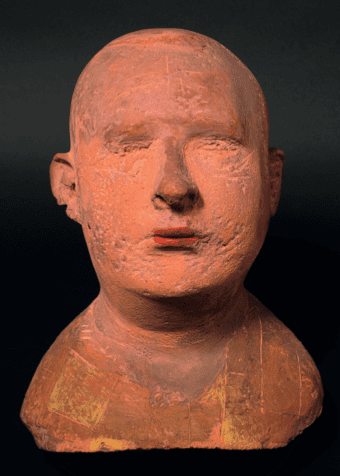
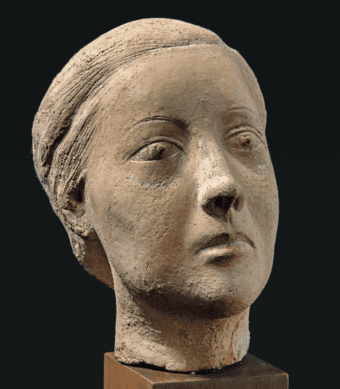
In the Portrait of Lucosius the ear is broken and there is a widespread punctuation effect on the head and face. While this intervention might suggest shaved hair or acned skin on the cheeks, in other places it becomes a purely optical complication. In the same way, the Portrait of Mrs. Verga appears entirely covered by scratches and small incisions. Moreover, there is a considerable rift on the woman’s neck. The role played by chromatic interventions is no different. From this perspective, the traces of red on the lips of both sculptures are particularly significant. In fact, the color was applied and partially erased by the sculptor. The same is true for the yellow touches on the bust of Lucosius. On the one hand, the color gives an effect of wear and tear; on the other, it almost suggests the idea of a checked shirt. Such a detail, in such an explicitly “archaeological” work, can only appear deliberately anachronistic. Likewise, the name “Lucosius” seems merely an ironic Latinization of the Italian name “Luca” – the name of the sitter, who was one of Marini’s pupils at the Istituto Superiore per le Industrie Artistiche (Institute for Industrial Arts, or ISIA) in Monza.49
In both cases the overall effect is a certain ambiguity between ancient and modern. The portraits preserve the expressive freshness of contemporary faces. At the same time, though, the subjects appear transfigured and remote in time. These faces are ancient and yet provocatively modern. In this sense, the scraping interventions on the portraits have the opposite meaning to those made on the female nudes, where they are used to give a more intense humanity and pictorial allure to the body. Here, their different and double purpose is, first, to accomplish an elegant archaeological effect, suitable to the public’s expectations, and, second, to avoid an excessive realism without sacrificing the exact features of the model. Marini understood well the risks of a trivial naturalism related to portraiture. Therefore, his interventions serve to cool down (also with a certain irony) any observation of the individual.
The Portrait of Lamberto Vitali (1937) is, on the other hand, a paradigmatic example of Marini’s interest in Egyptian portraiture (figure 15).50 First of all, one has to consider the sculptor’s decision to create the portrait in stone. In fact, like terracotta for the Etruscans, stone was a material commonly connected to Egyptian art at the time. However, most interesting of all are some specific stylistic solutions adopted by Marini. Indeed, the elongated shape of the head, the big lips, the raised chin, and the face’s intense expression appear explicitly taken from the aforementioned portraits of Akhenaten (figure 16). Not only were these among the most renowned works of ancient portraiture then known, Marini had also had the opportunity to study them around 1930, during trips to Paris and Berlin.51
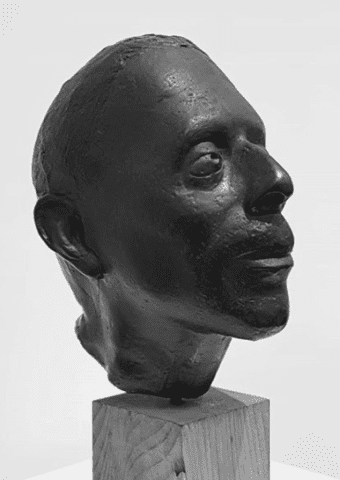
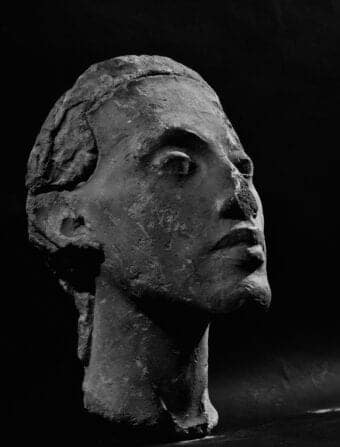
Vitali himself was certainly aware of this ancient reference. Furthermore, the archaeological model was probably meant to be openly recognizable by a sophisticated public. In the year that the portrait was executed, Vitali edited an important monograph on Marini. Not by chance, the collector defined the artist’s contact with Egyptian sculpture as “an encounter which results in the revelation of his own destiny.” According to Vitali, Egyptian portraits had provided Marini with a crucial lesson: the possibility of combining, in his works, natural datum and a sense of “plastic entirety.”52 In the same year, in commenting on the Portrait of Vitali, the critic Vincenzo Costantini spoke of an “essential Vitali, in his spirit and in his afterlife,” making an implied reference to the Ka. 53 The work was exhibited at the Venice Biennale in 1938. On that occasion, even Giuseppe Marchiori noticed a bond between Marini’s portrait and Egyptian art. Moreover, he specifically mentioned the same concept of “plastic entirety” that Vitali had talked about a year earlier.54
During the same Biennale, another portrait realized by Marini was put in relation to Egyptian sculpture: Portrait of Fausto Melotti (1937; figure 17).55 The work in question, especially its wax version, seems however to combine other important suggestions. Firstly, one must take into account another archaeological reference particularly popular in these years: Roman portraiture of late antiquity (figure 18). This is evident not only in the rendering of the beard through a hinted punctuation effect, but also in the peculiar expression of the face and the big eyes, which appear as if glancing laterally. These features of late ancient works were highlighted in several archaeological studies of the time. For example, the archeologist Silvio Ferri pointed out in his seminal article “Plotino e l’arte del III secolo” (Plotinus and the art of the third century CE, 1935) how the main features of these portraits were their “sentimentally visionary gaze” and “impressionistic” surface treatment.56 Secondly, even Melotti’s contemporary works seem to have provided a stimulating model for Marini. Indeed, the portrait appears based on a similar modularity of spherical, glossy, and abstract forms. In particular, Portrait of Melotti is reminiscent of the figures realized by Melotti himself for Coerenza (Coherence), a room designed by the BBPR Studio for the Milan Triennale in 1936 (figure 19). Lastly, the polished appearance of the work and the extreme synthesis of the volumes reveal specific attention to some Renaissance marbles, such as busts by Francesco Laurana (figure 20) – their stinging and yet sophisticated expressiveness representing a key model also for some of Marini’s later portraits, such as Noemi Bolla (1944; figure 21),57 to be compared to Laurana’s famous Female Bust in Vienna (figure 22).
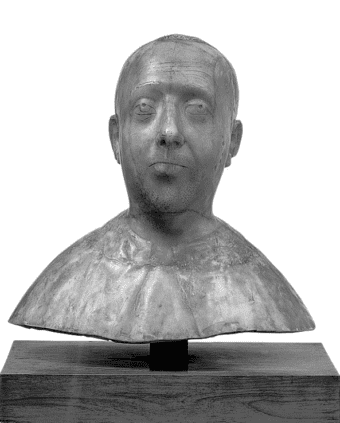
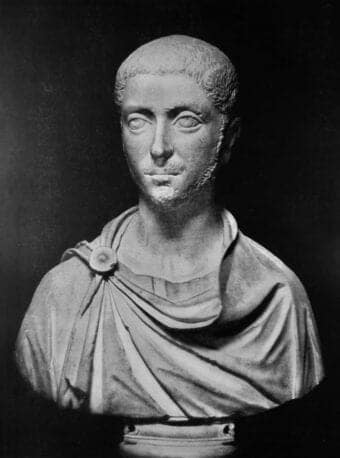
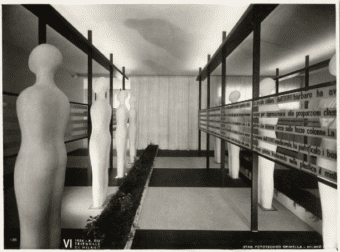
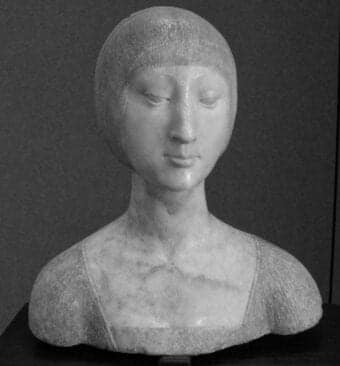
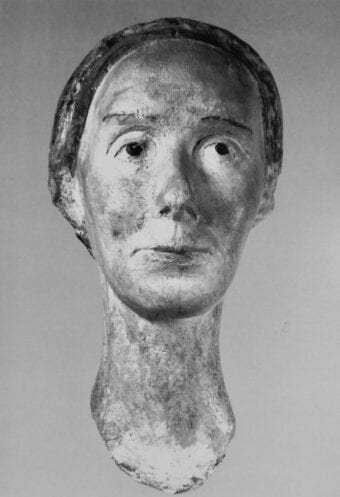
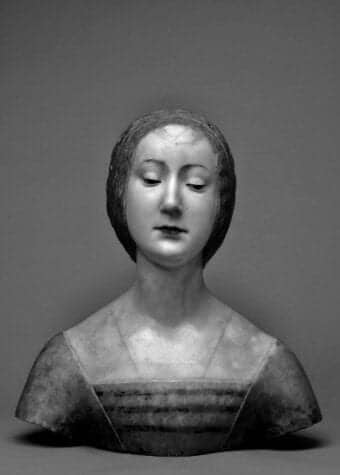
These heterogeneous and apparently incompatible references offered important starting points for Marini’s free reflection. Every single work was enriched by the sculptor with further plastic and chromatic interventions. Portrait of Melotti, for example, appears covered by a thick weave of lines, incised or in slight relief. “Natural lines” (creases, wrinkles, bags under the eyes) are crossed with “design lines,” traced in order to define the structure of the head. Compared to works such as Portrait of Lucosius, the effect is less explicitly archaeological. Yet its purposes remain the same: to underline the “otherness” between the work and the sitter, and to create a sophisticated portrait, halfway between extreme realism and complete abstraction.
Conclusion
Two main points emerge from this paper. Its first part focused on the figure of Sistina, a so-far-unknown model of Marini. The Sistina episode made it possible to analyze some of Marini’s sculptures with a new awareness. Moreover, it offered incentive to delve deeper into decisive but often neglected issues in the artist’s work: the female nudes, on the one hand, and the portraits, on the other. Starting from this reflection, the second part was devoted to Marini’s dialogue with antiquity in the two genres taken into account. A crucial aspect emerged: namely, the sculptor’s awareness in dealing with different models according to different expressive challenges, and also on the basis of coeval archaeological studies. Marini proved to be capable of reasoning intelligently on the problem of the sculptural fragment. He worked in a sophisticated way on the discrepancy between the synthesis of volumes and surfaces’ pictorial allure. He constantly played on the ambiguity between archaeological taste, stinging realism, and decorative abstraction. In both nudes and portraits, Marini was like an imaginative archaeologist. Through opposite ways, he created his fascinating characters, ancient yet modern.
Bibliography
III Quadriennale d’arte nazionale. Catalogo. Febbraio-Luglio 1939. Milan, Rome: Pizzi e Pizio, 1939. Exhibition catalogue.
Anti, Carlo. “Il R. Museo Archeologico di Venezia”. Dedalo 7, no. 3 (1926-1927): 599-637.
Anti, Carlo. La Venere maliziosa di Cirene. Milan: Treves-Treccani-Tumminelli, 1926.
Apollonio, Umbro. Marino Marini. Milan: Edizioni del Milione, 1953.
Argan, Giulio Carlo. “Giacomo Manzù, Marino Marini, Filippo de Pisis, Gino Panchieri”. Beltempo 3, (1942): 66-67.
Becatti, Giovanni. “Nuovo contributo ostiense di ritratti romani”. Le Arti 2, no. 1 (October-November 1939): 3-11.
Cagnetta, Mariella. “Il mito di Augusto e la “rivoluzione” fascista””. Quaderni di storia, no. 3 (1976): 139-181.
Cairola, Stefano. “Scultori. Marino Marini”. Omnibus (11 February 1947).
Carandente, Giovanni, ed. Marino Marini: catalogo ragionato della scultura. Milan: Skira, 1998.
Carotti, Giulio. L’arte dell’antico Egitto, edited by Eva Tea. Milan: Hoepli, 1937.
Costantini, Vincenzo. “Milano. Venti firme”. Emporium 85, no. 507 (March 1937): 164-165.
Dal Fabbro, Beniamino, Giansiro Ferrata, Leonardo Sinisgalli, and Arturo Tofanelli, eds. Il Tesoretto. Almanacco delle Lettere e delle Arti. Milan: Primi Piani, 1940.
De Grada, Raffaele. La grande stagione. Milan: Anthelios, 2001.
Della Pura, Eleonora. “Ritratti di Marini”. Le Arti 1, no. 3 (February-March 1939): 295-296.
Della Seta, Alessandro. Il nudo nell’arte. Milan, Rome: Bestetti & Tumminelli, 1930.
De Pisis, Filippo. Marino Marini. Milan: Edizioni della Conchiglia, 1941.
Farinella, Vincenzo. ““Vedere il sole attraverso occhi di terracotta”: alcune fonti archeologiche della scultura di Marino Marini”. In Marino Marini. Passioni visive, edited by Barbara Cinelli and Flavio Fergonzi, 62-85. Cinisello Balsamo: Silvana, 2017. Exhibition catalogue.
Fergonzi, Flavio. “Arturo Martini e le ricerche sulla terracotta nei primi anni Trenta”. Annali della Scuola Normale Superiore di Pisa. Classe di Lettere e Filosofia 16, no. 3 (1986): 895-930.
Fergonzi, Flavio. “Prima della fama internazionale. Temi della ricerca scultorea di Marino Marini tra gli anni trenta e i quaranta”. In Marino Marini. Passioni visive, edited by Barbara Cinelli and Flavio Fergonzi, 12-39. Cinisello Balsamo: Silvana, 2017. Exhibition catalogue.
Ferri, Silvio. “Plotino e l’arte del III secolo”. La Critica d’Arte 1, no. 1 (1935): 166-171.
Gentile, Emilio. Il culto del littorio: sacralizzazione della politica nell’Italia fascista. Rome: Laterza, 1993.
Giardina, Andrea. “Augusto tra due bimillenari”. In Augusto, edited by Eugenio La Rocca, 56-73. Milan: Electa, 2013.
Giglioli, Giulio Quirino. “Statue fittili di età arcaica”. Notizie degli scavi di antichità 44, nos. 1-3 (1919): 13-37.
Guerrisi, Michele. Discorsi su la scultura. Turin: Libreria Editrice di Cultura, 1931.
L’Isia a Monza. Una scuola d’arte europea, edited by Rossana Bossaglia. Cinisello Balsamo: Silvana, 1986.
Malvano, Laura. Fascismo e politica dell’immagine. Turin: Bollati Boringhieri, 1988.
Manacorda, Daniele. “Della Seta, Alessandro”. In Dizionario biografico degli italiani 37 (1989). http://www.treccani.it/enciclopedia/alessandro-della-seta_(Dizionario-Biografico)/.
Marchiori, Giuseppe. “La ventunesima Biennale di Venezia”. Emporium 87, no. 522 (June 1938): 285-319.
Marconi, Pirro. “L’arte nell’età di Augusto”. Emporium 86, no. 513 (September 1937): 477-490.
Margozzi, Mariastella. L’antico nel moderno. Scultura italiana degli anni trenta. Milano: Electa, 2012.
Marini, Marina (Mercedes Pedrazzini). Con Marino. Milan: Bompiani, 1991.
Marini, Marino. “Le mie sculture”. Tempo 4, no. 29 (14 December 1939): 19.
Mario Mafai, Marino Marini in una mostra nelle nostre sale. 15-29 marzo 1941. Genoa: Galleria Genova, 1941. Exhibition catalogue
Mucchi, Gabriele. “Incontro con Genni”. Domus 13, no. 146 (February 1940): 69-70.
Mucchi, Gabriele. Le occasioni perdute. Milan: Mazzotta, 2001.
Nelis, Jan. “Constructing Fascist Identity: Benito Mussolini and the Myth of Romanità”. Classical World: A Quarterly Journal on Antiquity 100, no. 4 (2007): 391-415.
Omaggio a Marino Marini. Milano: Silvana, 1974.
Pallottino, Massimo. “Studi sull’Arte Romana: l’orientamento stilistico della scultura aureliana”. Le Arti 1, no. 1 (October-Novembre 1938): 32-36.
Paribeni, Andrea. “Paribeni, Roberto”. In Dizionario biografico degli italiani 81 (2014). http://www.treccani.it/enciclopedia/roberto-paribeni_%28Dizionario-Biografico%29/.
Paribeni, Roberto. Il ritratto nell’arte antica. Milan: Treves, 1934.
Persico, Edoardo. Arte Romana. Supplement of Domus 8, no. 96 (December 1936).
Piovene, Guido. “Marino Marini”. Civiltà (21 October 1942): 57-64.
Pirovano, Carlo. Marino Marini scultore. Milan: Electa, 1972.
Pratesi, Mauro, and Giovanna Uzzani. La Toscana. Venice: Marsilio, 1991.
Pratesi, Mauro. “Scultura italiana verso gli anni Trenta e contemporanea rivalutazione dell’arte etrusca”. Bollettino d’arte 69, no. 28 (November-December 1984): 91-106.
Pratesi, Mauro. “Sulle tracce degli Etruschi: l’arte e la critica negli anni Venti e Trenta e Novecento”. Prospettiva, no. 46, (July 1986): 80-85.
Prisco, Gabriella. “Fascismo di gesso. Dietro le quinte della Mostra Augustea della Romanità”. In Snodi di critica, edited by Maria Ida Catalano, 224-259. Rome: Cangemi 2008.
Ragghianti, Carlo Ludovico. “Incontro con Marino Marini (parte 2)”. La Critica d’arte 44, no. 4 (January-March 1985): 53-62.
Read, Herbert, Patrick Waldberg, and Gualtieri di San Lazzaro, eds. Marino Marini, l’opera completa. Milan: Silvana, 1970.
Russo, Gianmarco. “I nudi femminili e le Pomone”. In Marino Marini. Passioni visive, edited by Barbara Cinelli and Flavio Fergonzi, 122-137. Cinisello Balsamo: Silvana, 2017. Exhibition catalogue.
Sestieri, Pellegrino Claudio. “Ritratto di una vecchia dama romana”. Le Arti 1, no. 4 (August-September 1939): 592-594.
Springer, Anton Heinrich, and Corrado Ricci. Manuale di Storia dell’Arte. I. Arte Antica. Bergamo: Istituto d’Arti Grafiche, 1904.
Vitali, Lamberto. Marino Marini. Milan: Hoepli, 1937.
Viveros, Maria. “Guerrisi, Michele”. In Dizionario biografico degli italiani 60 (2003). http://www.treccani.it/enciclopedia/michele-guerrisi_%28Dizionario-Biografico%29/.
Von Duhn, Friedrich. La Venere dell’Esquilino. Rome: R. Accademia dei Lincei, 1890.
- “Eseguì […] alcune versioni della Pomona avendo a modella quella semplice ragazza che si chiamava Sistina, studentessa di Belle Arti, e che gli fu vicina per anni fino a quando Marino l’abbandonò per una ragazza ricca che, più in bello, assomigliava stranamente a lei e che fu la Mercedes, poi diventata sua moglie.” Gabriele Mucchi, Le occasioni perdute (Milan: Mazzotta, 2001), 145. All translations, unless otherwise noted, are the author’s.
- See Il Tesoretto. Almanacco delle Lettere e delle Arti, ed. Beniamino Dal Fabbro, Giansiro Ferrata, Leonardo Sinisgalli, and Arturo Tofanelli (Milan: Primi Piani, 1940).
- See Gabriele Mucchi, “Incontro con Genni,” Domus 13, no. 146 (February 1940): 69–70; Mucchi, Le occasioni perdute, 143–47; and Raffaele De Grada, La grande stagione (Milan: Anthelios, 2001), 106.
- Marina Marini [Mercedes Pedrazzini], Con Marino (Milan: Bompiani, 1991), 14–15.
- Information on the provenance of Sistina was kindly provided by the staff of the archives of the Marino Marini Foundation, Pistoia.
- Marino Marini. Catalogo ragionato della scultura, ed. Giovanni Carandente (Milan: Skira, 1998), 80–81 (no. 114).
- Ibid., 100 (no. 141).
- III Quadriennale d’arte nazionale. Catalogo. Febbraio-Luglio 1939 (Milan, Rome: Pizzi e Pizio, 1939), 90–91.
- Marino Marini. Catalogo ragionato della scultura, 132 (no. 185).
- See Gianmarco Russo, “I nudi femminili e le Pomone,” in Marino Marini. Passioni visive, ed. Barbara Cinelli and Flavio Fergonzi (Cinisello Balsamo: Silvana, 2017): 122–37, especially 132.
- Marino Marini. Catalogo ragionato della scultura, 106–07.
- See Umbro Apollonio, Marino Marini (Milan: Edizioni del Milione, 1953); Carlo Pirovano, Marino Marini scultore (Milan: Electa, 1972); and Omaggio a Marino Marini (Milan: Silvana, 1974).
- See Mario Mafai, Marino Marini in una mostra nelle nostre sale. 15–29 marzo 1941 (Genoa: Galleria Genova, 1941).
- However, the same photograph was reproduced during the same year in Marino Marini, ed. Filippo de Pisis (Milan: Edizioni della Conchiglia, 1941). There, the nude was indicated as a bronze work of the Feroldi collection. It is likely that Marini did not have a photograph of both sculptures and, for this reason, he used the same one for both the Genoa catalogue and the de Pisis volume. This small inaccuracy is not certain proof, but it suggests the possibility that the Giovinetta discussed here is to be identified with the female nude exhibited in Genoa.
- “La figura, la statua impone, invece, una più vasta ricerca di forme, di linee, di masse. Le mie donne […] rispondono a questa preoccupazione.” Marino Marini, “Le mie sculture,” Tempo 4, no. 29 (December 14, 1939): 19.
- “Pessimo filologo […] accetta i fatti storici come li incontra: confusi, consunti, scalfiti, incrostati, deformi.” Giulio Carlo Argan, “Giacomo Manzù, Marino Marini, Filippo de Pisis, Gino Panchieri,” Beltempo 3 (1942): 66–67. See also Giulio Carlo Argan, Promozione delle arti, critica delle forme, tutela delle opere. Scritti militanti e rari (1930–1942), ed. Claudio Gamba (Milan: Marinotti, 2009): 176.
- See Vincenzo Farinella, “‘Vedere il sole attraverso occhi di terracotta’: alcune fonti archeologiche della scultura di Marino Marini,” in Marino Marini. Passioni visive, 62–85.
- Daniele Manacorda, “Della Seta, Alessandro,” in Dizionario biografico degli italiani 37 (1989): 476–81, http://www.treccani.it/enciclopedia/alessandro-della-seta_(Dizionario-Biografico)/.
- Alessandro Della Seta, Il nudo nell’arte (Milan and Rome: Bestetti & Tumminelli, 1930), 1–3.
- Ibid., 447.
- Today we know that several archaeological opinions about the two works were wrong, starting with their dating. Nowadays, for example, the Aphrodite of Cyrene is commonly accepted as a late Roman copy.
- See Friedrich Von Duhn, La Venere dell’Esquilino (Rome: R. Accademia dei Lincei, 1890).
- See Carlo Anti, La Venere maliziosa di Cirene (Milan: Treves-Treccani-Tumminelli, 1926).
- “Dietro la forma esiste il modello di una donna reale con i suoi pregi e i suoi difetti […] una sproporzione non rara ad incontrarsi in natura, il forte sviluppo della parte inferiore del corpo.” Della Seta, Il nudo nell’arte, 466 and 604.
- “Se la statua avesse avuto la sfortuna di giungere a noi acefala avrebbe avuto la fortuna che si sarebbe resa migliore giustizia alla sua arte.” Ibid., 454.
- “In tutti i tempi il corpo femminile, per la delicatezza dei suoi piani, oltre che plastica è stato colore.” Ibid., 156 and 304. Emphasis mine.
- “Meglio che sotto una superficie levigata, che ha sempre qualche cosa di cristallino, e quindi di rigido e d’inerte, il movimento dei piani, anche il più tenue, conserva così la morbidezza della carne viva.” Ibid., 456.
- See also, for example, the photograph of the Aphrodite of Cyrene in Michele Guerrisi, Discorsi su la scultura (Turin: Libreria Editrice di Cultura, 1931).
- See Mariastella Margozzi, L’antico nel moderno. Scultura italiana degli anni trenta (Milan: Electa, 2012).
- Marino Marini. Catalogo ragionato della scultura, 97 (no. 138) and 104 (no. 146).
- See Flavio Fergonzi, “Prima della fama internazionale. Temi della ricerca scultorea di Marino Marini tra gli anni trenta e i quaranta,” in Marino Marini. Passioni visive: 12–39, especially 28.
- “Uno stesso ordine di assolutezza plastica dello scomparso Maillol ma con un soffio di vita che mette l’accento sulla individualità dei modelli.” Stefano Cairola, “Scultori. Marino Marini,” Omnibus (February 11, 1947).
- See Russo, “I nudi femminili e le Pomone,” 131.
- “La messa in rilievo del suo tondo viso picassiano.” Eleonora Della Pura, “Ritratti di Marini,” Le Arti 1, no. 3 (February–March 1939): 296.
- Guido Piovene, “Marino Marini,” Civiltà (October 21, 1942): 57–64.
- Andrea Paribeni, “Paribeni, Roberto,” in Dizionario biografico degli italiani 81 (2014): 357–59, http://www.treccani.it/enciclopedia/roberto-paribeni_%28Dizionario-Biografico%29/.
- Roberto Paribeni, Il ritratto nell’arte antica (Milan: Treves, 1934), 4–9 and 17–19.
- Maria Viveros, “Guerrisi, Michele,” in Dizionario biografico degli italiani 60 (2003): 691–93, http://www.treccani.it/enciclopedia/michele-guerrisi_%28Dizionario-Biografico%29/. “Un duplicato del corpo […] il Ka, questa proiezione medianica del corpo nello spazio.” Guerrisi, Discorsi su la scultura, 37.
- “Assumendo come proprio appellativo di battaglia il titolo: colui che vive della verità […] allora il ritratto […] si afferma con una potenza non mai prima conosciuta.” Paribeni, Il ritratto nell’arte antica, 4.
- Anton Heinrich Springer and Corrado Ricci, Manuale di Storia dell’Arte. I. Arte Antica (Bergamo: Istituto d’Arti Grafiche, 1904).
- See Giulio Quirino Giglioli, “Statue fittili di età arcaica,” Notizie degli scavi di antichità 44, nos. 1–3 (1919): 13–37. See also Mauro Pratesi, “Scultura italiana verso gli anni Trenta e contemporanea rivalutazione dell’arte etrusca,” Bollettino d’arte 69, no. 28 (November–December 1984): 91–106; Mauro Pratesi, “Sulle tracce degli Etruschi: l’arte e la critica negli anni Venti e Trenta e Novecento,” Prospettiva, no. 46 (July 1986): 80–85; and Mauro Pratesi and Giovanna Uzzani, La Toscana (Venice: Marsilio, 1991).
- See, for example, Carlo Anti, “Il R. Museo Archeologico di Venezia,” Dedalo 7, no. 3 (1926–27): 599–637; and Edoardo Persico, Arte Romana, supplement to Domus 8, no. 96 (December 1936).
- See Mariella Cagnetta, “Il mito di Augusto e la ‘rivoluzione’ fascista,” in Quaderni di storia, no. 3 (1976): 139–81; Laura Malvano, Fascismo e politica dell’immagine (Turin: Bollati Boringhieri, 1988); Emilio Gentile, Il culto del littorio: sacralizzazione della politica nell’Italia fascista (Rome: Laterza, 1993); Gabriella Prisco, “Fascismo di gesso. Dietro le quinte della Mostra Augustea della Romanità,” in Snodi di critica, ed. Maria Ida Catalano (Rome: Gangemi 2008): 225–59; Jan Nelis, “Constructing Fascist Identity: Benito Mussolini and the Myth of Romanità,” in Classical World: A Quarterly Journal on Antiquity 100, no. 4 (2007): 391–415; and Andrea Giardina, “Augusto tra due bimillenari,” in Augusto, ed. Eugenio La Rocca (Milan: Electa, 2013): 56–73.
- “Quelle virtù espressive, momentanee, fulminee quasi, che fissano e incidono una realtà vivente.” Paribeni, Il ritratto nell’arte antica, 8.
- See Pirro Marconi, “L’arte nell’età di Augusto,” Emporium 86, no. 513 (September 1937): 477–90; Pellegrino Claudio Sestieri, “Ritratto di una vecchia dama romana,” Le Arti 1, no. 4 (August–September 1939): 592–94; Massimo Pallottino, “Studi sull’Arte Romana: l’orientamento stilistico della scultura aureliana,” Le Arti 1, no. 1 (October–November 1938): 33 and 36; and Giovanni Becatti, “Nuovo contributo ostiense di ritratti romani”, Le Arti 2, no. 1 (October–November 1939): 3–11.
- Marino Marini: catalogo ragionato della scultura, 78–79 (no. 108).
- Ibid., 90–91 (no. 128).
- See Flavio Fergonzi, “Arturo Martini e le ricerche sulla terracotta nei primi anni Trenta,” Annali della Scuola Normale Superiore di Pisa. Classe di Lettere e Filosofia 16, no. 3 (1986): 895–930.
- See Marino Marini, l’opera completa, ed. Herbert Read, Patrick Waldberg, and Gualtieri di San Lazzaro (Milan: Silvana, 1970), 326–27; and L’Isia a Monza. Una scuola d’arte europea, ed. Rossana Bossaglia (Cinisello Balsamo: Silvana, 1986), 24.
- Marino Marini. Catalogo ragionato della scultura, 88–89 (no. 124).
- See Paribeni, Il ritratto nell’arte antica, 3–5; and Giulio Carotti, L’arte dell’antico Egitto, ed. Eva Tea (Milan: Hoepli, 1937). See also Carlo Ludovico Ragghianti, “Incontro con Marino Marini (parte 2),” La Critica d’arte 44, no. 4 (January–March 1985): 53–62, especially 58.
- “Un incontro che si risolve nella rivelazione del proprio destino […] una rappresentazione del dato naturale, che tocchi un assoluto plastico.” Lamberto Vitali, Marino Marini (Milan: Hoepli, 1937), 13–14.
- “Un Vitali essenziale, nel suo spirito e, direi, nel suo al di là.” Vincenzo Costantini, “Milano. Venti firme,” Emporium 85, no. 507 (March 1937): 164.
- “Nell’incontro coll’arte egizia, Marini s’è purificato da ogni accenno realistica […] la conquista di un assoluto plastico.” Giuseppe Marchiori, “La ventunesima Biennale di Venezia,” Emporium 87, no. 522 (June 1938): 285–319, especially 292.
- Marino Marini. Catalogo ragionato della scultura, 94-95 (nos. 133 and 134).
- “I volti appariscono ora animati come mai lo erano stati […] impressionismo […] sguardo sentimentalmente sognante.” Silvio Ferri, “Plotino e l’arte del III secolo,” La Critica d’Arte 1, no. 1 (1935): 166-71, especially 170.
- Marino Marini. Catalogo ragionato della scultura, 183 (no. 261).

